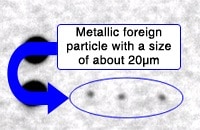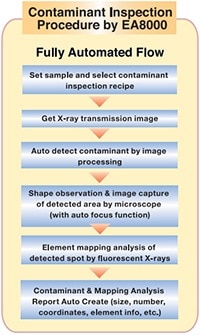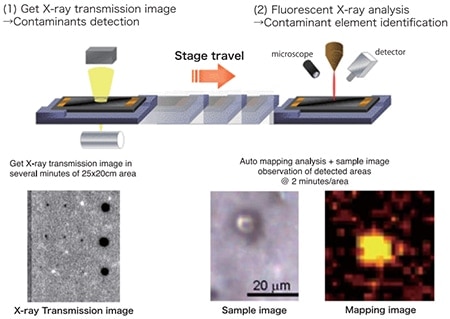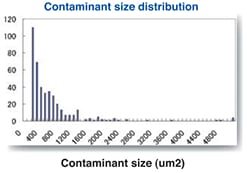X-ray Particle Contaminant Analyzer EA8000

Introducing the EA8000, for quality control of lithium ion secondary batteries and fuel cells
Makes the combination of 2 types of X-ray technology: “transparent”, and “fluorescence” to speed up detection of metallic foreign particles.
Lithium ion batteries (LIB), which are widely used in consumer equipment such as personal computers and mobile phones, have some issues such as overheating, fire accidents, etc. that have been reported in the past.
Starting from consumer products, lithium ion batteries have now been adopted to be used in automobiles or other transportation systems, and thus safety is now required more than ever.
One of the main causes of abnormal heat generation or fire in lithium ion batteries is that it has a short circuit. Some metallic contaminants can go to the short circuit. It is required to confirm the safety and performance of these batteries by controlling the contamination of metallic foreign particles.
Click on the link to jump to each menu.
Product Introduction: The EA8000
The EA8000 is a particle contaminant analyzer that can identify atomic elements through X-fluorescence analysis; the equipment utilizes radiolucency, which is the same principle used in CT scans and X-ray photos, to identify metallic foreign particles and capture the metallic particles in the sample. In X-ray fluorescence analysis, by using mapping analysis of the distribution of elements that can be obtained as a two-dimensional image, the elements of foreign metallic particles can be identified. The EA8000 achieves improvement of yield and ensures reliability in receiving inspection, in-process inspection and failure analysis at the actual site with regard to inspection of unevenness in composition and coating, and identification of foreign particles.
Special Features of the EA8000
(1)Detection of metallic foreign particles as small as 20µm by using transmission X-ray
Conventional X-ray CT systems require about 10 hours to detect metal particles 20µm in diameter in battery electrode plates 250×200 mm .
Hitachi High-Tech Science developed a new particle inspection technology, in combination with the X-ray transmission method, resulting in greatly reduced imaging time. Detection time can be reduced to 3 to 10 minutes, more than 100 times shorter than conventional times.

particle with a size of about 20µm
(2) From receiving inspection to process control of lithium ion secondary batteries
The EA8000 can measure materials ranging from powdered samples such as conductive additives, anode and cathode active materials, which are raw materials of lithium ion batteries, to sheet-like materials such as separators and electrode plates. In the inspection of metallic foreign particles contained in objects such as conductive additives, whose main components are carbon, which is a light element, it is possible to perform foreign particle inspection with the conductive additives still inside the bag, thereby making receiving inspection more efficient.

(3) Reducing the workload of the person doing the measurement through the use of automatic measurement
The EA8000 is able to perform automatic inspection of foreign particles from transmission images (through image processing), mapping analysis based on fluorescence analysis and generating reports. The operator does not have to spend much time on the equipment, the data is saved automatically, so the equipment can be used efficiently and safely.


(4) Create automatically the needed information
The EA8000 lists the size and location of the foreign particles detected from the radiolucent findings. The size and number of the distribution of foreign particles can be displayed by histogram, and makes trend management of the sizes and number of the foreign particles possible. Information about the element of foreign particles obtained by X-ray fluorescence analysis can automatically be reported.


